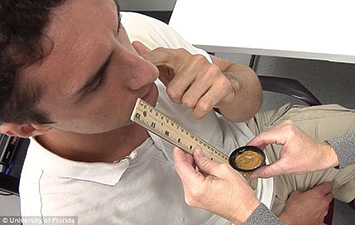 OK, so peanut butter is not your first thought as a possible game-changer in Alzheimer’s disease research. But it has potential, according to researchers at the University of Florida. They conducted a peanut butter smell test hoping to find an inexpensive, noninvasive way to detect early-stage Alzheimer’s and track its progress.
OK, so peanut butter is not your first thought as a possible game-changer in Alzheimer’s disease research. But it has potential, according to researchers at the University of Florida. They conducted a peanut butter smell test hoping to find an inexpensive, noninvasive way to detect early-stage Alzheimer’s and track its progress.
The test was conducted on cognitively normal individuals as well as:
- 18 patients diagnosed with probable Alzheimer’s disease.
- 24 patients with mild cognitive impairment.
- 26 patients with other causes of dementia.
The researchers found that the peanut butter test singled out those with probable Alzheimer’s.
PEANUT BUTTER SMELL TEST
Here’s how they conducted the test, according to the Cleveland Clinic, which recently published the result. The researchers asked each person to close their eyes, their mouth and one nostril. They opened a small container of peanut butter and moved progressively closer until the person could smell it. After measuring that distance, they waited 90 seconds and repeated the process with the other nostril.
In those with probable Alzheimer’s disease, the researchers had to move the peanut butter container an average of 10 centimeters closer to the left nostril than to the right nostril.
“This is a very interesting part of this study,” notes Dylan Wint, MD, a specialist in degenerative brain diseases who commented on the research. “There is a lot of research showing Alzheimer-related brain shrinkage usually starting on the left side of the brain, which is where the temporal lobe degenerates first.”
MORE RESEARCH NEEDED
The investigators, who published their study in 2013, said follow up research would be needed. However, a follow-up study in 2014 at the University of Pennsylvania could not replicate their results. The second research team found no difference in the ability of 15 patients with Alzheimer’s to smell peanut butter in their left versus their right nostrils.
“This highlights the scientific importance of studies being repeated and refined by other researchers in different patient populations,” says Dr. Wint. “Intriguing results don’t always hold true across all study populations.”
Research continues on Alzheimer’s disease as well as on mild cognitive impairment. Currently, the most accurate early-stage diagnostic tests for Alzheimer’s are a spinal tap or an amyloid PET scan. However, these tests are expensive, uncomfortable and not available everywhere.
“The amyloid PET scan can cost $5,000, and that is just to figure out who should be studied in any Alzheimer’s study for early-stage diagnosis,” he says.
September 21 was World Alzheimer’s Day. Accurate, accessible and inexpensive testing could inform more patients about their Alzheimer’s disease status. And diagnosing Alzheimer’s in its early stages is critical to finding treatments that can delay or prevent future memory loss.
Alzheimer’s symptoms
Here are some of the early signs of Alzheimer’s disease, as identified by the Fischer Center for Alzheimer’s Research Foundation. You should speak to your doctor if you are concerned about these things, as they could also be signs of other health issues.
• Difficulty performing otherwise familiar tasks, such as preparing a meal, opening a car window or using a household appliance.
• Memory loss that affects job skills. It is normal to occasionally forget an assignment or a colleague’s phone number, but it is not normal to frequently forget such things or to become so confused that you are unable to concentrate and cannot perform your job functions.
• Problems using language. Although it is normal to forget words, people with Alzheimer’s disease may substitute unusual words or phrases for forgotten ones.
• Disorientation to time and place. It is normal to sometimes lose track of time or to become lost, but a person with Alzheimer’s can forget what year it is and can become lost on familiar streets and not be able to find their way home.
• Loss of good judgment. This could take the form of wearing inappropriate clothing (e.g. pajamas worn outside in winter) or suddenly giving away large amounts of money.
• Problems with abstract thinking. It is normal to make a mistake balancing a checkbook, but people with Alzheimer’s disease may forget the meaning of numbers or what to do with them.
• Misplacing things. It is normal to misplace things occasionally, but putting things in unusual places, like an iron in the refrigerator or a watch in the sugar bowl are warning signs of Alzheimer’s disease.
• Rapid mood swings such as unexplained anger or going from apparent calm to sudden crying.
• Personality changes. As people age, their personalities may also gradually change, but for a person with Alzheimer’s disease the changes in personality are often sudden and dramatic.
• Loss of initiative, sleeping longer than usual, and loss of interest in the usual activities can be signs of depression, but are also warning signs of Alzheimer’s disease.


